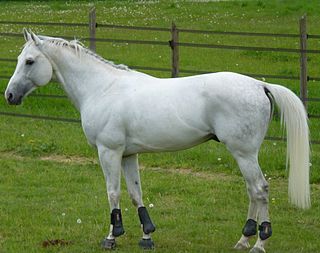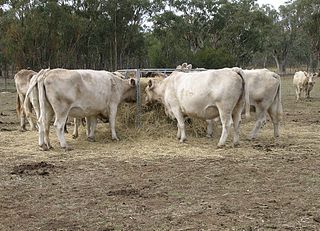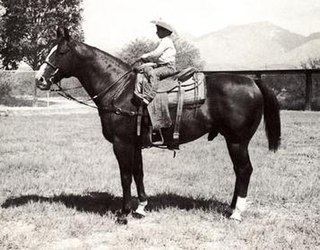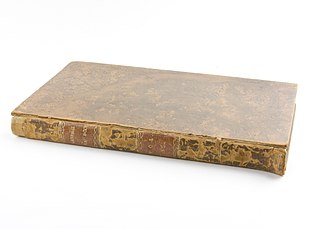
Horse breeding is reproduction in horses, and particularly the human-directed process of selective breeding of animals, particularly purebred horses of a given breed. Planned matings can be used to produce specifically desired characteristics in domesticated horses. Furthermore, modern breeding management and technologies can increase the rate of conception, a healthy pregnancy, and successful foaling.

Thoroughbred horse racing is an important spectator sport in Australia, and gambling on horse races is a very popular pastime with A$14.3 billion wagered in 2009/10 with bookmakers and the Totalisator Agency Board (TAB). The two forms of Thoroughbred horseracing in Australia are flat racing, and races over fences or hurdles in Victoria and South Australia. Thoroughbred racing is the third most attended spectator sport in Australia, behind Australian rules football and rugby league, with almost two million admissions to 360 registered racecourses throughout Australia in 2009/10. Horseracing commenced soon after European settlement, and is now well-appointed with automatic totalizators, starting gates and photo finish cameras on nearly all Australian racecourses.

A Hanoverian is a warmblood horse breed originating in Germany, which is often seen in the Olympic Games and other competitive English riding styles, and has won gold medals in all three equestrian Olympic competitions. It is one of the oldest, most numerous, and most successful of the warmbloods. Originally a carriage horse, infusions of Thoroughbred blood lightened it to make it more agile and useful for competition. The Hanoverian is known for a good temperament, athleticism, beauty, and grace.

Eclipse was an undefeated 18th-century British Thoroughbred racehorse who won 18 races, including 11 King's Plates. After retiring from racing he became a very successful sire and today appears in the pedigree of most modern Thoroughbreds.

The Anglo-Arabian or Anglo-Arab is a crossbred, part-Arabian horse that now also has its own status as a horse breed. It is the result of a Thoroughbred being crossed with an Arabian. The cross can be made between a Thoroughbred stallion and an Arabian mare, or vice versa. It can also be a cross between either an Anglo-Arab and a Thoroughbred or, alternatively, an Anglo-Arab and an Arabian. Another permitted cross is between two Anglo-Arabians. No matter the cross, a horse must have a minimum 12.5% of Arabian blood to be considered an Anglo-Arabian.

A stud animal is a registered animal retained for breeding. The terms for the male of a given animal species usually imply that the animal is intact—that is, not castrated—and therefore capable of siring offspring. A specialized vocabulary exists for de-sexed animals and those animals used in grading up to a purebred status.

A stallion is a male horse that has not been gelded (castrated). Stallions follow the conformation and phenotype of their breed, but within that standard, the presence of hormones such as testosterone may give stallions a thicker, "cresty" neck, as well as a somewhat more muscular physique as compared to female horses, known as mares, and castrated males, called geldings.

The Sardinian, Sardinian Anglo-Arab, Italian: Anglo-Arabo Sardo or AAS, is a horse breed from the Mediterranean island of Sardinia, where it has been selectively bred for more than one hundred years. It derives from cross-breeding Thoroughbred horses with Sardinian horses carrying Arabian blood.
Depth Charge (1941–1965) was a Thoroughbred son of Bold Venture who went on to become an outstanding sire of American Quarter Horse racehorses. He was posthumously inducted into the AQHA Hall of Fame

Lightning Bar (1951–1960) was an American Quarter Horse who raced and subsequently became a breeding stallion. He was bred by his lifelong owner Art Pollard of Sonoita, Arizona, and was the offspring of Three Bars, a Thoroughbred, and Della P, a Quarter Horse mare from Louisiana, then noted for the breeding of sprint horses. Lightning Bar raced ten times, achieving four victories and four other top three finishes. His racing career was cut short by illness after only one year, following which he spent two years as a show horse. As a breeding stallion he sired seven crops, or years, of foals, among whom Doc Bar was the best known. In 1960 Lightning Bar died of an intestinal infection at the age of nine. He was inducted into the American Quarter Horse Association's (AQHA) Hall of Fame in 2008.

Thoroughbred breeding theories are used by horse breeders in an attempt to arrange matings that produce progeny successful in horse racing. Bloodstock experts also rely on these theories when purchasing young horses or breeding stock. A basic understanding of these theories can also help the racing public understand a horse's theoretical genetic potential. The breeding theories stem from the belief that careful analysis of bloodlines can lend predictability to breeding outcomes. A well-designed mating increases the probability of the offspring's success, although many other factors also come into play.
The Tersk Stud was officially established on February 11, 1921, on the orders of Marshal Semyon Budyonny. The breeding farm was used to restore the Russian horse population, which suffered heavy losses during the Russian Revolution.
The Japan Bloodhorse Breeding Association is a public company established to manage the racehorse breeding industry in Japan.

The Henneke horse body condition scoring system is a numerical scale used to evaluate the amount of fat on a horse's body. It was developed in the early 1980s by Don Henneke at Texas A&M University with the goal of creating a universal scale to assess horses' bodyweight, and was first published in 1983. It is a standardized system that can be used across all breeds without specialized equipment; condition is assessed visually and by palpation. Scores range from 1 to 9 with one being poor and nine being extremely fat; the ideal range for most horses is from 4 to 6. The system is based on both visual appraisal and palpable fat cover of the six major points of the horse. The system is used by law enforcement agencies as an objective method of scoring a horse's body condition in horse cruelty cases.
Saxon (1871–1895) was a British-bred American-trained Thoroughbred racehorse that won the 1874 Belmont Stakes, the eighth running of that stakes race.

The Australian Stud Book (ASB), is the body responsible for ensuring the integrity of Thoroughbred breeding in Australia. Australia is the second-largest Thoroughbred breeding country in the world behind the US. The principal functions of the ASB include identification procedures along with DNA testing of mares and foals and the recording of a mare’s progeny and stallion statistics. In 2003 the ASB introduced microchips for foals, which is the most secure means of horse identification when and combined with freeze branding, provides racing officials with the most dependable identification system in the world.
L'Abbesse de Jouarre was a Thoroughbred racehorse that won the 1889 Epsom Oaks. The horse was owned by Lord Randolph Churchill and the Earl of Dunraven during her three-year racing career. She was nicknamed "Abscess on the Jaw" during her career due to the difficulty the public had pronouncing her name. A versatile racehorse, she was able to win major races at distances ranging from six furlongs to one and a half miles. Retired from racing in 1891, L'Abbesse was the dam of the influential German broodmare Festa and the leading stallion Desmond. L'Abbesse de Jouarre died 6 March 1897 during foaling.
Average earnings index (AEI) is a popular statistic used in North American Thoroughbred horse breeding. It is used to put the earnings of a breeding animal's progeny into proper perspective.

Kenneth L. "Ken" Ramsey and Sarah Kathern "Kitten" Ramsey are horse breeders and owners of Thoroughbred race horses. They have multiple graded stakes winners, three Breeders' Cup winners, and the Ramseys themselves have won multiple Eclipse Awards for outstanding owner and breeder. Ken and Sarah own Ramsey Farm, a 1,200 acre horse breeding operation in Nicholasville, Kentucky, and have raced horses at tracks throughout the United States. Many of their race horses have names incorporating the word "Kitten", Ken's nickname for Sarah Ramsey, used as the inspiration for the name of their leading stallion, Kitten's Joy, a successful racehorse in longer races on turf racetracks. When his style of racing proved unfashionable and outside breeders were reluctant to send mares to him, the Ramseys bought a herd of their own mares to breed and raced the progeny themselves, with considerable success, punctuated by Ken Ramsey personally leading most of his horses into the winner's circle after their races. To further promote the stallion, most of his offspring have "Kitten" in their names and, in some cases such as Breeders' Cup winners Bobby's Kitten and Stephanie's Kitten, the Ramseys honor friends or family members by incorporating their names as well.















